When my friend Vindhya planted her vegetable garden in Vancouver earlier this year, she couldn’t have known that, come mid- summer, nestled among the thriving Solanaceae – tomatoes, chilli peppers, and eggplants – another member of the family, Solanum nigrum– had invited itself to the party, and was popping up all over the plot.
Commonly known as black nightshade, there’s a good deal of confusion regarding the edibility and potential toxicity of this, and related plants. (If in doubt, weed it out! Please read and verify, before eating that weed! )
Many gardeners here might have just pulled the interlopers up without a second thought. Vindhya, on the other hand, was delighted to recognise the weed as a popular variety of potherb that she is very familiar with from gardens and hedgerows in Coorg, where, it is known as kaaké thopp (crow leaves). I’m not sure why. Perhaps it’s because of the deep purple-black shade of the ripe fruit that’s reminiscent of the sheen on a crow’s feathers.
The plant has great nutritive value, and both leaves and fruit are considered invaluable in the treatment of ulcers. Cooked tender leaves and shoots of kaaké thopp, have a deep, peppery, spinach-like flavour. The leaves can be dried and stored for use throughout the year.
Unripe berries are extremely bitter, and should not be eaten raw. They can, however, be preserved (soaked in yogurt or buttermilk, and salt, then sun dried) for use as a crisp, fried accompaniment to a meal. This is more common in Tamil Nadu, where it is known as manathakkali vathal.
This simple stir fry is a popular way to enjoy kaaké thopp.
Kaaké thopp palya
- 4 cups rinsed and coarsely chopped kaake thopp leaves
- 1 medium onion, diced
- 1-2 green chillis, slit
Or
1 dry red chilli, broken into large pieces
- 1 tsp mustard seed
- 2 tbsp fresh grated coconut
- 2 tbsp oil (preferably coconut)
- Salt to taste
Heat the oil in a pan and sputter the mustard, then add the red chilli, if using. Add the onions and slit green chillis, and sauté on medium heat until the onions soften and just begin to brown.
Add the kaake thopp and stir to mix. Cover and allow to steam on medium heat, until the leaves soften. Stir occasionally to prevent sticking.
Add salt to taste, then dry out the palya on low heat and add the coconut before serving.
The ripe berries (kaaké pann) are quite delicate and need to be picked gently. Their flavour is somewhat like a mix of cape gooseberry crossed with a tomatillo, and a little hint of grape skin. As a child, I can’t recall ever finding more than a few ripe kaaké pann at a time on the shrubs that grew around my grandparent’s home. (This may have been partly due to the competition from other eager foragers!)
The long, hot summer produced a bumper crop of kaaké thopp, and with it, an abundance of berries. When I came across an unusual recipe for wine made from ripe kaaké pann, Vindhya handed me a large bowlful so I could try it out.
Mandepanda Savitha Poovaiah, a talented cook and keen wildlife photographer based in Coorg, shares this recipe that she in turn learned from her mother-in-law.
It turns out a beautiful, rosy purple wine with a unique fruity flavour. If you have an opportunity to make this, definitely give it a try!
Kaaké pann wine
- Black nightshade berries – 1 cup
- Sugar – 1½ cups
- Cinnamon – 1 small stick
- Cloves –2
- Water – 4 cups
Collect Black nightshade berries as they ripen and store rinsed berries in the refrigerator until you find the quantity suitable for the recipe.
Take an air tight container, put the berries into water, and add sugar and spices. Tighten the lid and store it until you decide to consume it as either juice, or after letting it ferment for around 20 days, as wine.
Filter the solids out before bottling.
Caution: Juice for the young ones and wine for adults!
It’s a long way from Coorg to Vancouver, about 13000 km as the crow flies. But in a moment of delicious serendipity, this recipe just came together.
Now that’s something to crow about! 😉
Thank you for sharing,Vindhya Somaiah and Mandepanda Savitha Poovaiah! 🙂
Editor’s note: There was a delay in the appearance of this post due to a technical glitch, which I just got around to fixing after returning from my travels.

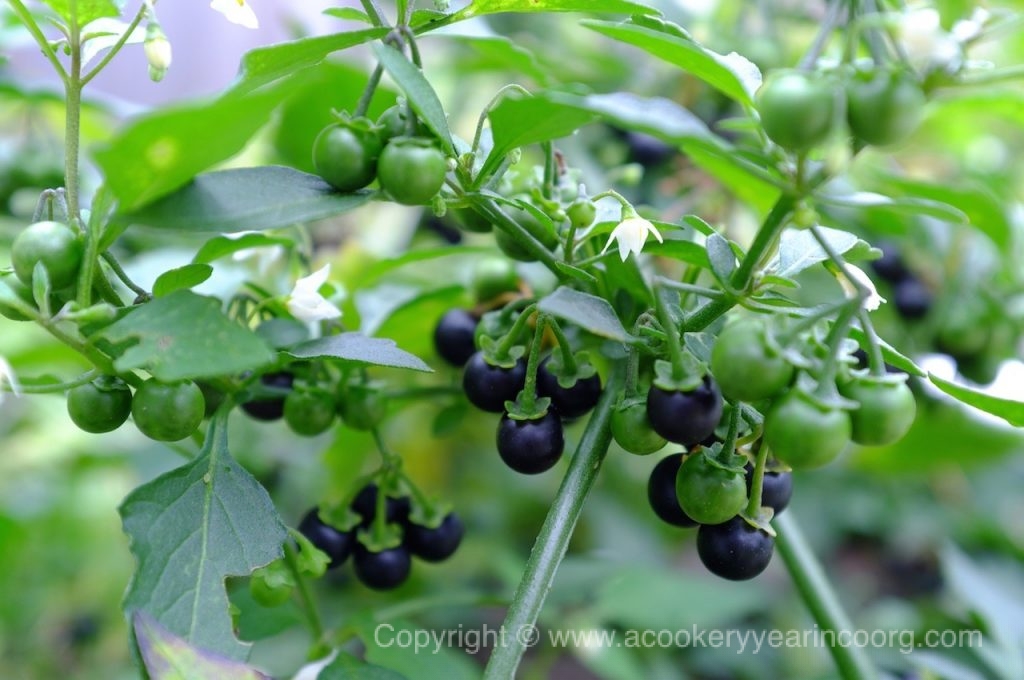
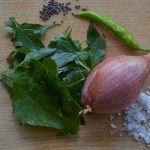
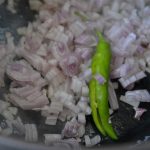
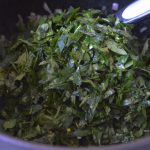
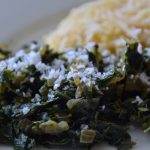
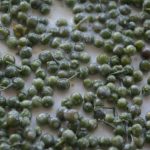
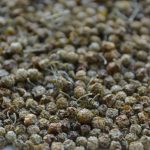
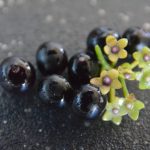
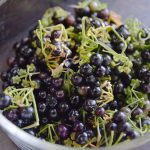
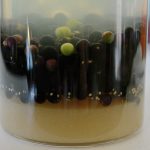
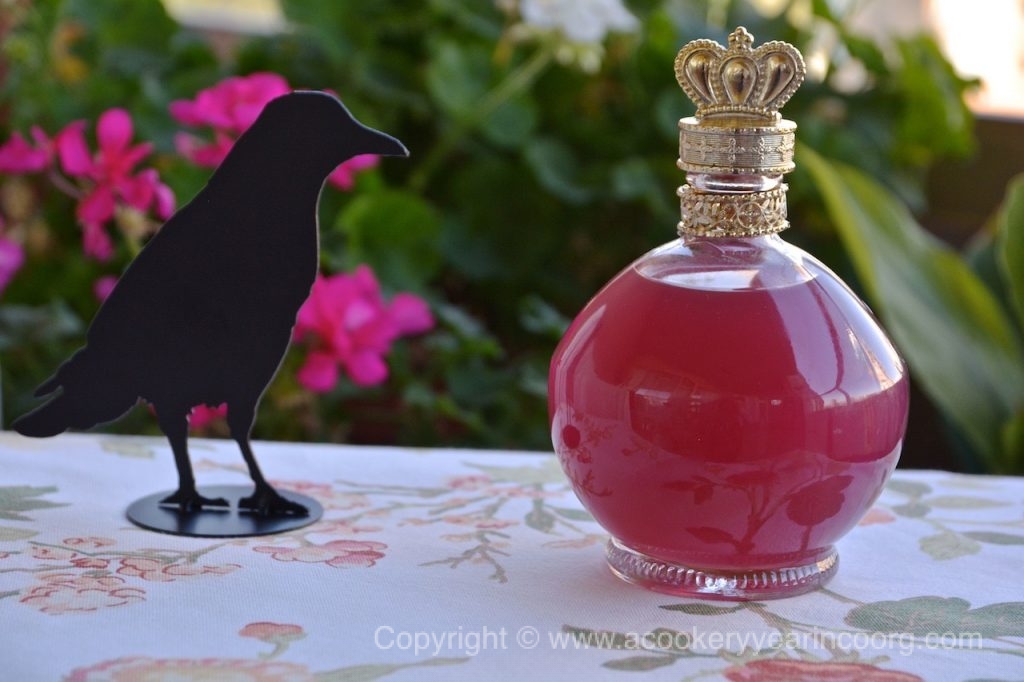
As always what a very interesting article Shalini. Can’t believe black nightshade (aka manathakkali in Tamil and Malayalam) grows in Vancouver! Where did your friend get the seeds for it? Chopped leaves of this plant when mixed with dosa batter makes very tasty dosa. And the berries salted and sun-dried are excellent.
Thank you, Ammini. Lovely to see you back online!
My friend didn’t actually plant any Solanum nigrum – it’s very likely they were mixed up with the tomato seeds. The growing conditions on the West coast this summer were just right, and she had a huge harvest of leaves and perfectly ripened fruit. I made manathakkali vathal too, albeit oven dried, and they turned out really well. The wine recipe was a lovely surprise!
Dear Shalini, I feel like a proud mom to see the picture of Kaake Thoppe from my garden in your fantastic blog. It is normally considered a weed in this part of the world, but I have been told as a kid how nutritious it is and the high content of Iron in it. We were so happy to see it spring up all over the garden. Not sure how it found place in my garden, but we had to make Otti a few times this year just to eat the Kaake Thoppe stir fry.
The Wine that you made was awesome, quite interesting how we Kodavas end up making wine out of anything:)
Happy Kaveri Shankramana and may you have the choicest blessings of Kaveri all around the year.
Hi Vindhya, you have every right to be proud of the thought and work you put into your garden – what a happy harvest it turned up. 🙂
I couldn’t believe my luck, when Mandepanda Savitha Poovaiah shared her recipe for kaaké pann wine and you just happened to have loads of berries, ripe and ready in your backyard. By the way, I added the second batch of berries to the wine, so the colour and flavour have intensified. This might be the perfect drink to share at a Halloween party! 🙂
I love the flavour of the leaves in a palya, or even added to a simple dal. The dosa Ammini mentions sounds delicious too. Next year, hopefully if the plants spring back as vigourously as this summer, we”ll be ready with more recipes!
Thank you, again, Vindhya, for sharing, and for taking time to drop by and comment.
Here’s wishing you and the family a very Happy Kaveri Shankramana.